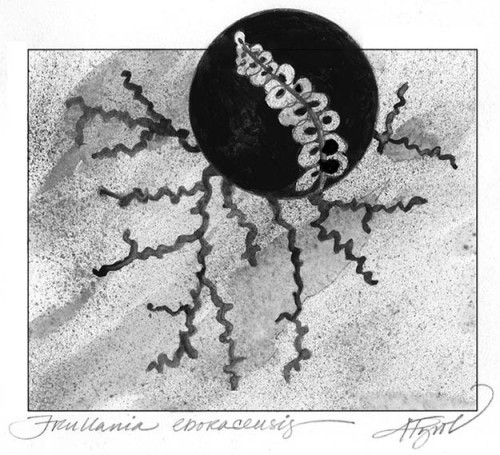
Rugged overthrust ridges, deep shady valleys, mysterious caves, lush forests, buried rivers, and barren wastelands. Weird, wonderful, and sometimes sinister creatures prowl the land, lie in wait for their prey, sacrifice themselves for their offspring, or excavate intricate tunnels. Want to visit? Leave your passport at home, and grab a hand lens as you head out the door to the nearest tree.
Bark landscapes are amazingly varied, with complex topography, many microclimates, and habitats both harsh and mild. Old trees offer the best flora-watching, as their thick, furrowed, spongy bark holds enough moisture and nutrients to support a mini-rainforest; young trees, on the other hand, seem relatively desert-like.
On most trees in our area, you’ll find three distinct types of nonvascular flora – mosses, liverworts, and lichens. Non-vascular means that these organisms lack water-transporting vessels, and absorb their water from the tree bark or the atmosphere.
If you view tree bark as a micro-landscape, the lush, green patches of moss most resemble forests, and for good reason: like trees, mosses are green and have leaves. The leaves are tiny and soft, with a central vein, and spiral around the stem. I’ve noticed that mosses often cluster around knots, furrows, or old branch scars on tree trunks, the ‘mountains’ in the topography of bark. With greater relief, these bark features catch moisture and (sometimes) sunlight, and are some of the most fertile parts of the trunk. Mosses also drape emerald skirts around the bases of many trunks.
Liverworts grow almost everywhere, and a few moments studying bark will probably turn up these little plants. Frullania eboracensis, a leafy liverwort, looks like a miniature brownish, living version of rickrack (that flat zigzag sewing material). It also occurs frequently around bark knots, appearing from afar like a dark patch of felt. Up close, it’s a riot of compact branches and hand-lens-worthy round leaves that alternate on the stem, unlike the spiraling leaves of mosses. Like impeccable handwriting caught daydreaming, Frullania branches outward from a central mass, undulating tightly across the mesas and canyons of tree bark, branching repeatedly into fragments and unfinished thoughts.
Frullania’s little brown leaves provide habitats for even smaller creatures: bdelloid rotifers. These animals measure less than a millimeter and live inside Frullania’s tiny, spherical leaf lobes, projecting their mouths out to feed from films of water that coat the liverwort and bark. Frullania not only provides moisture and shelter, but its branches net insect dung, bits of soil, feathers, and tree detritus – a cornucopia to its animal inhabitants.
Lichens often grow amid, over, and alongside mosses and liverworts. These odd organisms are not plants at all; they result from two or more organisms, including fungi and algae, forming a symbiotic relationship. Some leafy lichens can be the largest organisms on a tree trunk. One of these, Punctelia rudecta, ripples from a central point in overlapping, pale gray-green wavelets, like a fossilized splash of milk. Individuals can be several inches in diameter.
Crustose lichens look like splotches of paint, from delicate watercolor washes to thick oil brushstrokes in colors from white to orange to green. One, Conotrema urceolatum, appears almost exclusively on sugar maple bark, and can help you identify the tree. It’s a flat, opaque white patch with tiny black dots. Up close, the dots look like microscopic bagels.
Mosses, lichens, liverworts, rotifers, and the myriad other species that populate tree bark interact in complex ways that scientists are still working to understand. For example, mossy trunks have more diverse leafy lichens, while less mossy trunks host more crustose lichens. Out in the woods, I like to remember how findings like this began: with a curious, patient observer, wandering into exotic worlds nestled in the crevices of one tree.

